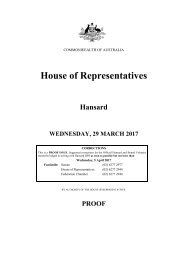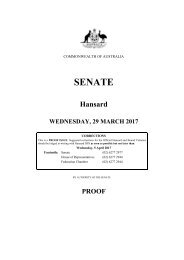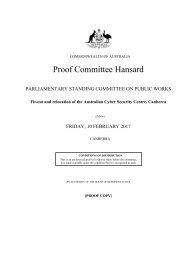SENATE
2e7N9wg
2e7N9wg
Create successful ePaper yourself
Turn your PDF publications into a flip-book with our unique Google optimized e-Paper software.
Thursday, 13 October 2016 <strong>SENATE</strong> 107<br />
If it’s $1 that leaves Canberra, what is it that hits Fitzroy Crossing—10c, 20c?<br />
… … …<br />
They probably need to have a look at how their policies are working and they need to have indicators on how those funds are<br />
rolled out …<br />
Similar criticisms have been made by the Indigenous leaders who contributed to the Wunan Foundation's<br />
Empowered Communities report in 2015, which noted:<br />
Vast swathes of funding are absorbed by the red tape of administration within the government bureaucracy, and on the<br />
‘middlemen’ between government and Indigenous people.<br />
The report that has now been produced by the Centre For Independent Studies contains multiple real-life examples<br />
of where money is not always going to areas of greatest need and where a heavily centralised approach is not<br />
adequately respecting input from Indigenous people themselves into program design and delivery.<br />
One such example noted in the report also come to my own attention through a report from the Australian<br />
National Audit Office at the end of 2015 into the operation of the Indigenous Home Ownership Program. The<br />
program itself has a worthy objective: to facilitate home ownership among Indigenous Australians by addressing<br />
barriers such as lower incomes and savings pools, credit issues and limited experience with loan repayments. In<br />
essence, the program is designed to make basic home loans available to Indigenous Australians who, because of<br />
those factors I have just outlined, might otherwise struggle to obtain one.<br />
However, the National Audit Office report found this objective was not being met. It found funding is not being<br />
directed where it is most needed and that loans are increasingly provided to medium- and high-income earners,<br />
people who would quite easily qualify for a home loan from a mainstream banking institution. Yet the program's<br />
administrator, Indigenous Business Australia, does not generally conform with other lenders that a customer<br />
cannot access mainstream finance, even though this is considered a key eligibility threshold for the Indigenous<br />
Home Ownership Program. In fact, the National Audit Office report recommended the government consider<br />
whether, after 40 years of operation, a government-run loan program is any longer necessary or the most efficient<br />
way to improve the rates of Indigenous home ownership. The response from Indigenous Business Australia to this<br />
suggestion was decidedly mute, as was its response to previous reports criticising its Indigenous business loan<br />
program. In 2013-14, it approved a grand total of 75 loans—around one loan for every bureaucrat employed to<br />
administer it. Surely, we can do better than this?<br />
These are just two examples from the litany that were examined by the research of the Centre for Independent<br />
Studies. Time and again, there is evidence presented which suggests that many Indigenous programs are being<br />
established and evolving in response to perceived need. As a result, there are a plethora of programs coming on<br />
stream which duplicate existing programs. The lack of requirement for evidence based funding is leading to<br />
expenditure growth with no commensurate improvement in outcomes.<br />
The CIS report identified a total of 1,082 Indigenous-specific programs. Of these, 49 are funded federally, 236<br />
are delivered by state and territory governments, and 797 are delivered by non-government organisations, though<br />
often with funding that comes from governments. Of the 1,082 programs, just 88—eight per cent—have been<br />
audited or evaluated in any meaningful way to determine the effectiveness of their outcomes. Given the waste,<br />
mismanagement and ineffectiveness that has been found in those programs which have been evaluated, the fact<br />
that 92 percent have not been evaluated should be alarming to all of us. All up, these programs are estimated to<br />
cost taxpayers at least $5.9 billion every year—but Indigenous people are seeing precious little benefit from these<br />
large investments of taxpayers' dollars.<br />
At the same time, even more taxpayer money is being spent by advocacy groups to pursue political outcomes<br />
that will deliver no tangible benefit to health and education outcomes across Indigenous communities. Take the<br />
Recognise campaign as a shining example. It was established to raise awareness of proposals to recognise<br />
Indigenous Australians in the Constitution. After four years and around $20 million in funding from taxpayers,<br />
research that was released by the Recognise campaign itself in May this year showed that awareness has actually<br />
fallen—down 10 per cent among Indigenous people and down 13 per cent among non-Indigenous people.<br />
As someone who pays close attention to constitutional debates, I cannot recall seeing a single TV<br />
advertisement, receiving any leaflets in my mailbox or being doorknocked by this taxpayer funded campaign<br />
operation. So where has the $20 million gone? What is Recognise actually doing to meet its supposed objective of<br />
raising awareness? Why is awareness falling? Why is Recognise continuing to actively recruit paid field staff to<br />
campaign when there is no referendum question finalised and the referendum itself appears to have been delayed?<br />
It is a textbook example of why providing taxpayers' money to third parties to fund their political campaigns is a<br />
bad idea. (Time expired)<br />
CHAMBER















